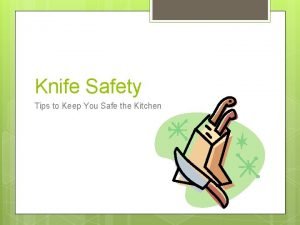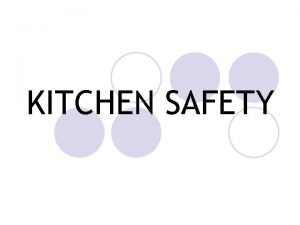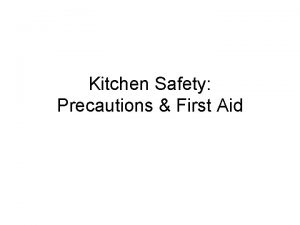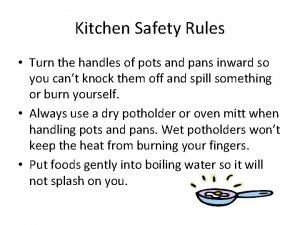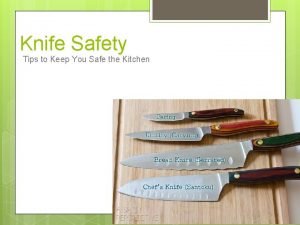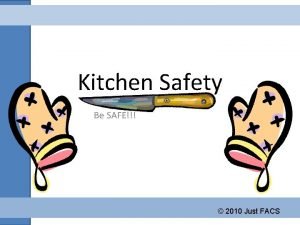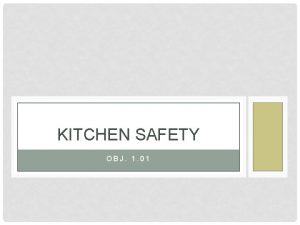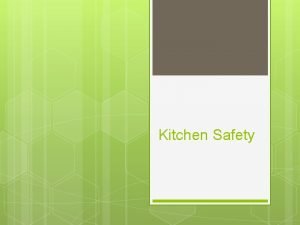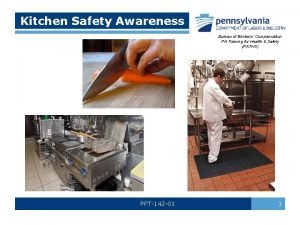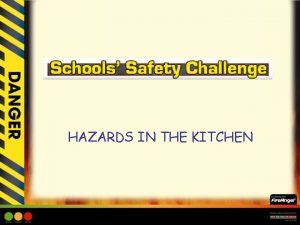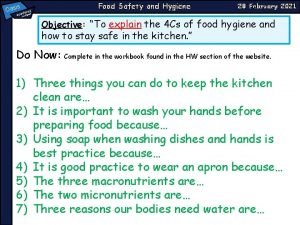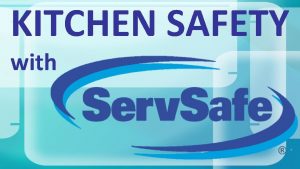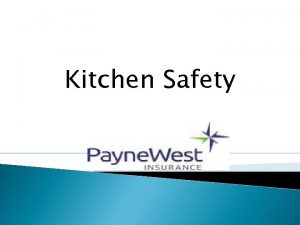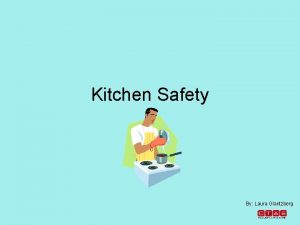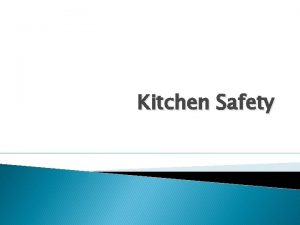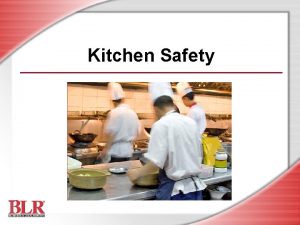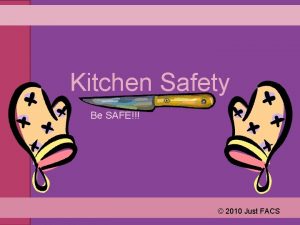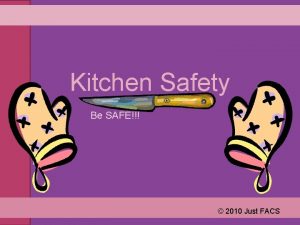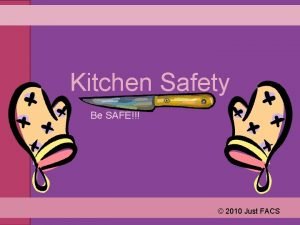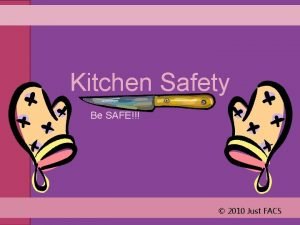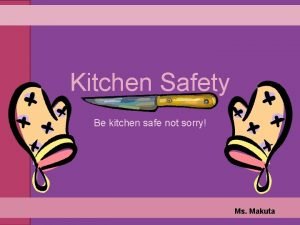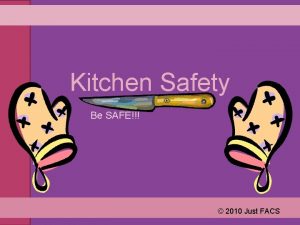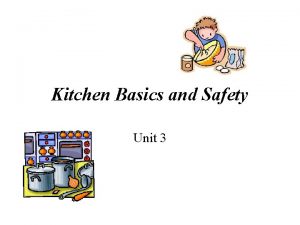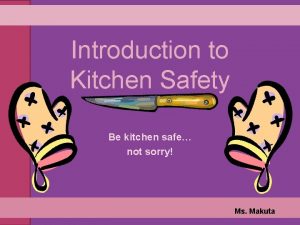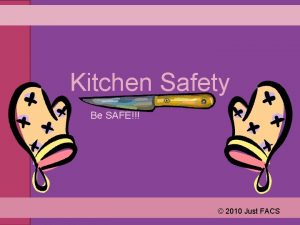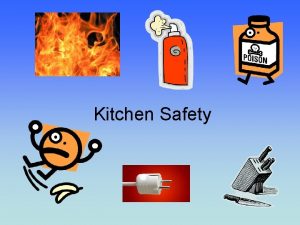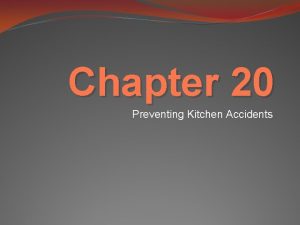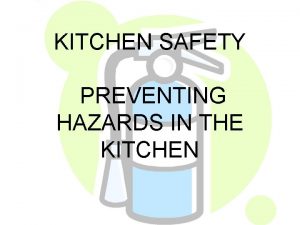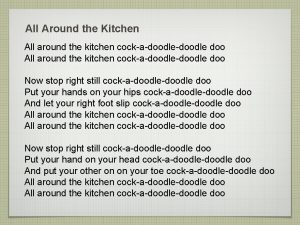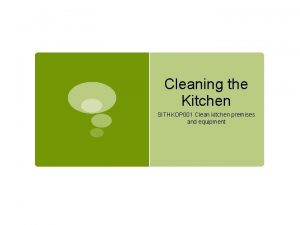Kitchen Safety Why is safety in the kitchen







































- Slides: 39

Kitchen Safety Why is safety in the kitchen important?

No one likes to cut a finger on a knife, get burned or slip and fall. Most of us, however, have had one or more of these accidents. SAFETY in the kitchen means using precautionary methods in the kitchen to prevent an accident. Most accidents in the kitchen are due to carelessness.

SAFETY first. How much do you already know about kitchen safety? For each question below, decide whether the practice is safe or unsafe. Click the box next to each question to reveal the answer. UNSAFE 1. Use a towel or your apron to remove a pan from the oven. SAFE 2. Pour salt or baking soda over the flames of a grease fire. SAFE 3. Wipe up spills on the floor right away. UNSAFE 4. Pour water on a grease fire. 5. Tie back long hair. UNSAFE 6. Climb up on the counter to get items from the top shelf. UNSAFE 7. Use electric appliances with wet hands. UNSAFE 8. Wearing loose clothing while working in the kitchen. SAFE UNSAFE 9. Cut away from your body when using a sharp knife. 10. Keep cabinet doors open so everything is in easy reach.

Kitchen Safety Tips for Preventing Burns/Fires Preventing Falls Preventing choking Preventing Cuts Preventing Electric Shock

Where’s the Hazard?

General Safety Guidelines • Pay Attention! • Do not let hair, jewelry, sleeves dangle – catches fire or get tangled in appliances. • Keep your mind on what you’re doing. • Prevent clutter – Clean up as you go and put things away. • Close drawers and doors.

General Safety Guidelines • Keep pets away from stove • Make sure to keep matches and lighters out of the hands of children. Put them in high places where tiny hands can't get to them • Avoid keeping anything above the stove • Do not keep matches where children can reach them

General Safety Guidelines • Walk in the kitchen no running • Make sure you check your fire or smoke detector at least once a month • Never allow baby walkers in the kitchen • Know where your shut off valves are in the house • Use back burners

General Safety Guidelines • Use the right tool for the job. • Store heavy or bulky items on low shelves. • Create a kid free zone in kitchen while cooking • Foods in microwave heat up at different temperatures –mix thoroughly to prevent burning

Safety in the Kitchen Keys to preventing kitchen accidents are: • careful kitchen management • safe work habits

KITCHEN HAZARDS INCLUDE Falls Cuts Electrical shock Choking Strains Poisoning Fires and Burns

FALLS


Preventing Falls • Tips • • Keep floors clean and clutter free Get rid of slippery throw rugs Repair damaged flooring Foot gear is proper- no floppy slippers, tie shoes, flip-flops, or open-toed shoes • Dispose of broken glass right away • Use a footstool to get to high places, not chairs • Treating Falls • Leave person on floor if anything seems to be broken • Get help

CUTS

Preventing Cuts Tips • • • Treatment for cuts Keep Knives sharp and use • Clean cuts by running proper technique under warm water Don’t cut with slippery/oily – Apply pressure if hands bleeding is heavy Use a cutting board with a • Apply antibacterial damp cloth underneath crème or spray Wash knives separately • Bandage with clean Don’t try to catch a falling knife gauze or band-aid • • • Keep fingers away from rough surfaces, slicing edges and rotating beaters • Sweep up glass immediately with broom and dustpan

Consumer product safety commission estimates over 137, 000 people receive hospital treatment for injuries from kitchen knives each year.

ELECTRICAL SHOCK

Preventing Electrical Shock Tips Treatment • No aluminum foil or any metal in • Unplug appliance the microwave • Do not touch appliance or • Don’t plug in several appliances person at once • Notify adult • Always unplug appliances after use • Make sure hands are dry when dealing with electric appliances • Keep all electrical appliances and cords away from water • Do not remove items from a toaster with a metal object.

– GFCI (Ground Fault Circuit interrupter) outlets should be used in kitchens. If there is a surge or short in the appliance, wiring or plug, the GFI will shut down the power.

Preventing CHOKING Tips Treatment • Chew with your mouth closed • Apply Heimlich maneuver • Don’t talk and laugh with your • Call 911 mouth full • Don’t play with your mount food • Chew your food thoroughly before swallowing

Preventing STRAINS Definition: to impair, injure, or weaken (a muscle, tendon, etc. ) by stretching or overexertion Prevention of strains: – Bend at the knees when lifting something. This prevents back strain. – Always use a cart to carry heavy things in the kitchen.

POISONING

Preventing Poisoning Hazardous Chemicals: – Cause burns, breathing difficulties and poisoning. – Read labels. – Never transfer hazardous products to another container. – Never mix different chemical products. – Never mix compounds such as bleach/ammonia. – Use charcoal / BBQ outside ONLY – gives off carbon monoxide.

FIRES AND BURNS

Preventing Burns • • Tips Treating Minor burns Keep hair tied back • Run under cool water Always use oven mitts • Apply lotion, moisturizer or burn crème Turn panhandles inward Tilt pot lid away from face to • Cover loosely with clean gauze prevent burns from steam Clean grease and bits of food off oven Never try to move or carry a burning pan Pull oven rack out with hot pads Do not use wet/damp hot pads

Preventing Fires • Never throw water, flour or baking powder on a grease fire. -will cause it to explode • Use baking soda, salt or extinguisher • Do not turn on the exhaust fan over the stove-the fire into the walls of your home! • Keep combustible materials away from stoves or other heat sources (Paper towels, cookbooks, dishtowels) • Make sure knobs are turned in off position at all times on stove. • Keep towels and other materials away from heating elements

How to Handle Kitchen Fires

How to use a fire extinguisher: Check the gauge to see if there is enough pressure in it to get the chemicals out to stop the fire. Use the PASS system: Pull the pin Aim it at the base of the fire Squeeze the handle Sweep the stream side to side at the base of the fire.

Pan Fires • slide lid over top • Turn off oven • Leave pan at stove

Oven Fires • Turn off heat and keep the door closed • Call fire department to report the fire • Have appliance serviced before you use it again

Toaster or Microwave Fires • Keep door closed • Unplug appliance • Call fire department to report the fire • Have appliance serviced before you use it again

If YOU Catch on Fire Stop Drop Roll

What is important to have in a kitchen in case of an emergency or to help detect an emergency?

First aid kit Emergency numbers Fire extinguishers Fire and smoke detectors

STATISTICS • Most fires start in the kitchen than any other place in the home. • Cooking fires are the #1 cause of home fires and home fire injuries • One person is either burned or scalded every 25 seconds in the USA

STATISTICS • • There is a noticeable peak in kitchen fires occurring around 6 p. m. The most common material ignited in kitchen fires 1. 37% -oil, fat, grease 2. 13. 5 % food, starch, flour 3. 10. 3 % plastic

STATISTICS • Unattended cooking is the leading cause of home cooking fires • 2/3 of the time fires start within the first 15 minutes of cooking • The stove is the #1 fire hazard in the kitchen

Resources • American College of Emergency Physicians (2001). First Aid Manual. New York: Dorling Kindersley Limited. • Barbie Arnold (2005). Akron, OH: The University of Akron. • Boy Scouts of America (1996). Safety- Merit Badge Series. Irving, Texas: Boy Scouts of America. • Hall, J. (January, 2005). Home cooking patterns and trends. Quincy, MA: National Fire Protection Association. • U. S. Fire Administration/National Fire Data Center (Oct. , 2004). • Websites Used: www. nfpa. org www. dos. state. ny. us www. forburns. com/burn_safety. html www. keepkidshealthy. com
 Pictures
Pictures Prepositions of place
Prepositions of place In the kitchen or at the kitchen grammar
In the kitchen or at the kitchen grammar Dont ask why why why
Dont ask why why why Kitchen knife safety tips
Kitchen knife safety tips Kitchen safety definition
Kitchen safety definition Kitchen safety precautions
Kitchen safety precautions In a kitchen, pots with handles that are loose
In a kitchen, pots with handles that are loose Knife safety tips
Knife safety tips Food safety poster
Food safety poster Kitchen safety jeopardy
Kitchen safety jeopardy Obj 1
Obj 1 Knife safety poster
Knife safety poster Kitchen safety awareness
Kitchen safety awareness Hazards in the kitchen
Hazards in the kitchen Thbank
Thbank Hát kết hợp bộ gõ cơ thể
Hát kết hợp bộ gõ cơ thể Ng-html
Ng-html Bổ thể
Bổ thể Tỉ lệ cơ thể trẻ em
Tỉ lệ cơ thể trẻ em Gấu đi như thế nào
Gấu đi như thế nào Thang điểm glasgow
Thang điểm glasgow Chúa yêu trần thế
Chúa yêu trần thế Môn thể thao bắt đầu bằng chữ đua
Môn thể thao bắt đầu bằng chữ đua Thế nào là hệ số cao nhất
Thế nào là hệ số cao nhất Các châu lục và đại dương trên thế giới
Các châu lục và đại dương trên thế giới Công của trọng lực
Công của trọng lực Trời xanh đây là của chúng ta thể thơ
Trời xanh đây là của chúng ta thể thơ Mật thư tọa độ 5x5
Mật thư tọa độ 5x5 Làm thế nào để 102-1=99
Làm thế nào để 102-1=99 độ dài liên kết
độ dài liên kết Các châu lục và đại dương trên thế giới
Các châu lục và đại dương trên thế giới Thơ thất ngôn tứ tuyệt đường luật
Thơ thất ngôn tứ tuyệt đường luật Quá trình desamine hóa có thể tạo ra
Quá trình desamine hóa có thể tạo ra Một số thể thơ truyền thống
Một số thể thơ truyền thống Cái miệng nó xinh thế
Cái miệng nó xinh thế Vẽ hình chiếu vuông góc của vật thể sau
Vẽ hình chiếu vuông góc của vật thể sau Nguyên nhân của sự mỏi cơ sinh 8
Nguyên nhân của sự mỏi cơ sinh 8 đặc điểm cơ thể của người tối cổ
đặc điểm cơ thể của người tối cổ Thế nào là giọng cùng tên
Thế nào là giọng cùng tên




